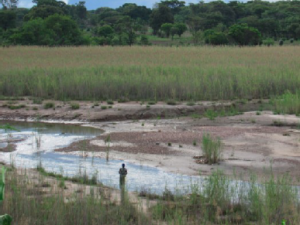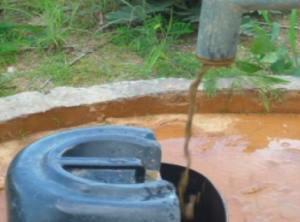
2nd June. This article also appeared in the Lusaka Times on May 19th. On 2nd April the Supreme Court of Zambia upheld a precedent High Court verdict that Vedanta subsidiary Konkola Copper Mines (KCM) is guilty of major water pollution which turned the Kafue into a river of acid in 2006 and poisoned thousands of people, some of who have suffered long term impacts to their liver, kidneys and other functions(1). But the $2 million compensation originally awarded by the High Court to 2001 victims who self organised to sue KCM, has been reduced to virtually nothing, denying them their long due justice.(2)
Now lead claimant James Nyasulu has been receiving threats and harassment from agents working on behalf of KCM, telling him not to fight this multinational company, which has connections in the judiciary.Nyasulu and the committee of claimants have evidenced multiple incidents of procedural irregularities, bribery and corruption during their nine year struggle for legal redress:
-
When victims went with their families to local clinics and hospitals (many sponsored by Vedanta) in November 2006 after drinking contaminated water, they were unable to get medical reports as staff feared they would be dismissed. This was noted in the 2011 High Court judgement1 but ignored in the recent Supreme Court verdict, which only granted the 12 out of 2001 claimants who had medical reports any possibility of damages, leaving 1,989 victims with nothing.
-
The claimant’s first lawyer, Kelvin Bwalya (KBF Associates), was initially employed by them when he occupied a very small office, with one vehicle, in the back streets of Lusaka. Several years after taking their case he had inexplicably amassed a fleet of 12 new cars, and moved to large offices and residence in the centre of the capital city. They reported these discrepancies to the court which recused him on grounds of corruption in 2009.2
-
One of the three judges on the bench of the first Supreme Court hearing on 3rd June 2014 in Ndola, was former KCM lawyer Albert Wood.3 This major conflict of interest should have admitted to the Chief Justice by Justice Wood according to Zambian law, but was only addressed due to the intervention of the claimants, after which he was removed from the bench.
-
KCM’s lawyers Nchito and Nchito abandoned the case before 3rd February 2015, and KCM instructed Malombo and Malombo in their place, who wrote letters to the claimant’s lawyer Mr K Shepande, advising him of a false date for Supreme Court hearing (6th Feb instead of 5th Feb). However Malombo and Malombo were never been appointed before court or had their documents stamped and filed, though they appeared in court for KCM on 2nd April. Instead, the final judgement again named Nchito and co as KCM’s advocates.
-
Following the 2nd April Supreme Court verdict, a printed version of the judgement was not released until 6th May 2015, during which time Mr Nyasulu waited in Lusaka, periodically camping in the office of the Chief Justice to demand access to the delayed judgement, as he could not afford another expensive journey from Chingola in the Copperbelt to the capital city. During this period Nyasulu received many death threats and threatening calls telling him not to fight KCM.4

Nine years after the pollution occurred twenty two of the original 2001 claimants have now died, some from liver and kidney damage potentially caused by the poisoned water. The rest fear they will never get real justice before they also pass away. Other local people have experienced miscarriages and other birth problems. James Nyasulu from Chingola, lead claimant in the case, who worked for ZCCM from 1987 until 2000, says:
.
“I know about mining processes and the processes Vedanta use are very different to ZCCM. Yes, ZCCM still polluted but they released very small amounts. Vedanta is polluting with impunity and on a much larger scale and it is still happening all the time. When the water goes off for 2 or 3 days then you know there has been pollution. All those people who drink from the Kafue – from Chililabombwe to Lusaka – they have drunk polluted water at least once. The diseases those industrial chemicals cause cannot even be treated in our hospitals, but the government is not thinking of that.”
.
London based solidarity group Foil Vedanta claim that disregard for domestic laws and for human and ecological life, and reliance on bribery and corruption is typical of KCM’s parent company Vedanta:
.
Vedanta has repeatedly been accused of bribery and corruption in India. In Puri, Odisha, the company’s attempts to acquire 10,000 acres of land for a corporate university were heavily aided by the state.5 Several weeks ago former, Chief Secretary of Odisha, B K Patnaik, who helped push the scheme, left his government employment to become President of the University project.6 During the Forest Bench hearing of the case challenging Vedanta’s now banned Niyamgiri mine in 2009, Justice S H Kapadia and senior counsel Harish Salve admitted they were shareholders of Sterlite, but were allowed to continue in the case nonetheless.7
.
Vedanta’s large donations to the two main Indian political parties between 2004 and 2012 were ruled as illegal by the Delhi High Court in March 2014.8
.
In 2009 Vedanta’s iron mining subsidiary Sesa Goa Western Cluster Ltd, obtained a 1 billion tonne iron ore reserve in Liberia, for just $123.5 million (a fraction of its true value) in a abnormal deal with Israeli company Elenilto.9
.
In Rajasthan, India Vedanta bought state company Hindustan Zinc Limited for £64 million in 2002 (valued by BNP Paribas), against a true value of £2.5 billion.10 Their current attempt to buy the remaining 30% government shares is being opposed in the Indian Supreme Court.11
Notes to Editors:
(1) On 6th November 2006 one of KCM’s tailing pipelines burst, spilling highly acidic waste into the Chingola stream, which meets the Mushishima stream and then joins the River Kafue, providing water to 40,000 Zambians from Chililabombwe to Lusaka. It was not until 8th November 2006 that the Environmental Council of Zambia (ECZ) became aware of the spill and ordered KCM to cease operations at the tailings plant12. Local water companies Mulonga and Nkana Water stopped supplies as they were highly polluted and the entire Chingola district was without water for six to ten days13. Those who did not receive tanked water drank directly from the Kafue and its tributaries which was highly acidic and contained 10x acceptable levels of copper, 770x manganese, and 100x cobalt, turning the river bright blue with copper sulphate precipitate.14 Thousands of people became sick with diarrhoea, vomiting and loss of sight, and many later developed kidney and liver problems amongst other long term illnesses. Miscarriages and birth problems have also been recorded in the affected communities, as well as premature deaths with unknown causes.15
.
The ECZ later reported that the effluent was almost pure acid at PH 2.8, while other sources reported PH 1.516. Worse still KCM had knowingly been operating the Tailings Leach Plant without lime, which is usually used to neutralise acidic effluent,17 for up to a week, a major violation of KCM’s license to release effluent under Zambia’s Water Pollution Control (Effluent and Waste Water) Regulations of 1993 and KCM’s Environmental Management Plan.18
.
(2) On 2nd April 2015 the Supreme Court finally gave its judgement, upholding the High Court verdict that KCM was guilty of negligence, gross pollution and disregarding the right to life. However, they disagreed with Justice Phillip Musonda’s judgement that the twelve available medical records were indicative of the damage to other claimants who had shared the same water sources but did not have medical evidence. Instead the court ruled that only the twelve plaintiffs with medical records could be compensated, and the degree of damages would have to be assessed by the Deputy Registrar of the High Court.19 In reality that could mean that KCM pays virtually none of the High Court’s $2 million damages award, let alone the substantial interest it would now have attracted. The referral of damages claims back to the High Court is also procedurally abnormal.
.
.
References:
1.High Court of Zambia Judgement, 1st January 2011. Nyasulu and Others v Konkola Copper Mines Plc and Others.www.zamlii.org/zm/judgment/high-court/2011/86
2 http://www.mwebantu.com/2014/05/08/lusaka-high-court-uphelds-lazs-decision-to-suspend-lusaka-lawyer-kelvinbwalyas-practicing-certificate/
3 See Consent Order between James Nyasulu and 2000 others and KCM, 2007 which is signed by A.M Wood, advocate for the 1st defendant (KCM).
4A diary of threatening calls and content provided by Nyasulu is available.
5Rahul Pandita, ‘The Curious Case of Vedanta University: How the Orissa government bent over backwards to help billionaire Anil Agarwal’ | OPEN Magazine August 21, 2012. http://www.openthemagazine.com/node?page=503
6http://indianexpress.com/article/india/india-others/ex-orissa-chief-secy-helped-vedanta-get-land-for-univ-now-gets-top-job-there/
7http://www.hindustantimes.com/india-news/vedanta-case-sc-judge-clarifies-on-bias-charge/article1-461570.aspx
8 http://in.reuters.com/article/2014/03/28/india-election-donations-vedanta-idINDEEA2R0DZ20140328
9http://allafrica.com/stories/201405291265.html
10Pls contact Foil Vedanta for documentary evidence of valuation etc
11http://articles.economictimes.indiatimes.com/2014-12-17/news/57154393_1_remaining-government-stake-stake-sale-residual-stake
12Supreme Court of Zambia Judgement, 2nd April 2015. Konkola Copper Mines Plc and James Nyasulu and 2000 others.
13 Fraser, A and Lungu, J., 2006, For Whom the Windfalls: Winners and losers in the privatisation of Zambia’s copper mines.
14KCM pollutes Kafue River, Times of Zambia, November 8 2006.
16KCM Pollution Victims Speak Out, Sunday Post, Lusaka, November 19 2006 cited in Fraser, A and Lungu, J., 2006, For Whom the Windfalls: Winners and losers in the privatisation of Zambia’s copper mines.
17Environmental Council of Zambia Press Release, 22 December 2006. Konkola Copper Mines Plc discharge of acidic effluent into the Kafue river follow up action.
18Supreme Court of Zambia Judgement, 2nd April 2015. Konkola Copper Mines Plc and James Nyasulu and 2000 others.
19Supreme Court of Zambia Judgement, 2nd April 2015. Konkola Copper Mines Plc and James Nyasulu and 2000 others.